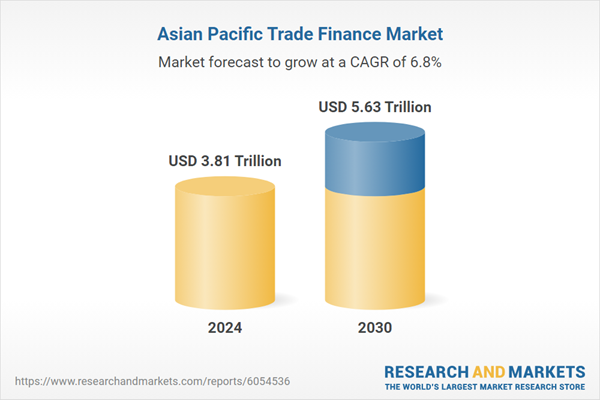Speak directly to the analyst to clarify any post sales queries you may have.
10% Free customizationThis report comes with 10% free customization, enabling you to add data that meets your specific business needs.
Key Market Drivers
Growth in Cross-Border Trade and Economic Expansion
A significant driver of the Asia Pacific trade finance market is the region’s expanding cross-border trade. Asia Pacific is home to some of the world’s largest economies, including China, India, Japan, and South Korea, all of which are major players in global trade. The establishment of trade agreements like the Regional Comprehensive Economic Partnership (RCEP) and the Comprehensive and Progressive Agreement for Trans-Pacific Partnership (CPTPP) has further facilitated trade flows among member nations. These agreements foster tariff reductions, harmonized trade policies, and improved market access, contributing to the growth in trade activities. Over the past decade, cross-border trade volumes have increased by approximately 25%, and while the COVID-19 pandemic caused a temporary slowdown, global trade is rebounding and expected to more than double in 2024.Key Market Challenges
Limited Trade Finance Access for SMEs
A major challenge facing the Asia Pacific trade finance market is the limited access to financial services for small and medium-sized enterprises (SMEs). While SMEs play a crucial role in driving trade and economic growth, they often struggle to secure trade financing due to stringent credit requirements, a lack of collateral, and limited financial history. Traditional banks and financial institutions tend to prioritize large corporations with established credit profiles, leaving many SMEs underserved. According to the Asian Development Bank (ADB), there is a global trade finance gap exceeding USD 1.7 trillion, a substantial portion of which is concentrated in Asia Pacific. Many SMEs face difficulties in obtaining letters of credit, export credit insurance, and other trade finance products, limiting their ability to expand internationally.Key Market Trends
Rising Influence of Fintech and Blockchain Technology
The growing presence of fintech companies and the adoption of blockchain technology are reshaping trade finance in Asia Pacific. Fintech firms are introducing innovative financing solutions, including alternative lending models, digital payment platforms, and AI-powered risk assessment tools, which make trade finance more accessible and efficient. These solutions provide businesses with faster and more flexible financing options, reducing their dependence on traditional banking systems.Blockchain technology is also playing a pivotal role in improving transparency, security, and efficiency within trade finance. By enabling decentralized and tamper-proof transactions, blockchain minimizes the risk of fraud and fosters greater trust among stakeholders. The use of smart contracts, which automate trade finance agreements, is simplifying payment processes and reducing transaction disputes.
Key Market Players
- DBS Bank Ltd.
- Industrial and Commercial Bank of China
- Mizuho Bank, Ltd.
- Sumitomo Mitsui Banking Corporation
- Australia and New Zealand Banking Group Limited
- HDFC Bank Limited
- Standard Chartered Group
- Oversea-Chinese Banking Corporation Limited
- Bank of China Limited
- Hongkong and Shanghai Banking Corporation Limited
Report Scope
This report segments the Asia Pacific Trade Finance Market into the following categories, alongside detailed industry trends:
By Product Type:
- Letters of Credit
- Export Factoring
- Insurance
- Bill of Lading
- Guarantees
- Others
By Service Provider:
- Banks
- Trade Finance Houses
- Others
By Application:
- Domestic
- International
By Country:
- China
- Japan
- India
- South Korea
- Australia
- Indonesia
- Singapore
- Vietnam
- Malaysia
- Thailand
Competitive Landscape
Company Profiles: In-depth analysis of the leading companies in the Asia Pacific Trade Finance Market.Available Customizations:
TechSci Research offers customized versions of the Asia Pacific Trade Finance Market report to meet specific business needs. The following customization options are available:
Company Information
- Detailed analysis and profiling of up to five additional market players.
This product will be delivered within 1-3 business days.
Table of Contents
Companies Mentioned
- DBS Bank Ltd.
- Industrial and Commercial Bank of China
- Mizuho Bank, Ltd.
- Sumitomo Mitsui Banking Corporation.
- Australia and New Zealand Banking Group Limited
- HDFC Bank Limited
- Standard Chartered Group
- Oversea-Chinese Banking Corporation Limited
- Bank of China Limited
- Hongkong and Shanghai Banking Corporation Limited
Table Information
| Report Attribute | Details |
|---|---|
| No. of Pages | 131 |
| Published | February 2025 |
| Forecast Period | 2024 - 2030 |
| Estimated Market Value ( USD | $ 3.81 Trillion |
| Forecasted Market Value ( USD | $ 5.63 Trillion |
| Compound Annual Growth Rate | 6.7% |
| Regions Covered | Asia Pacific |
| No. of Companies Mentioned | 10 |









